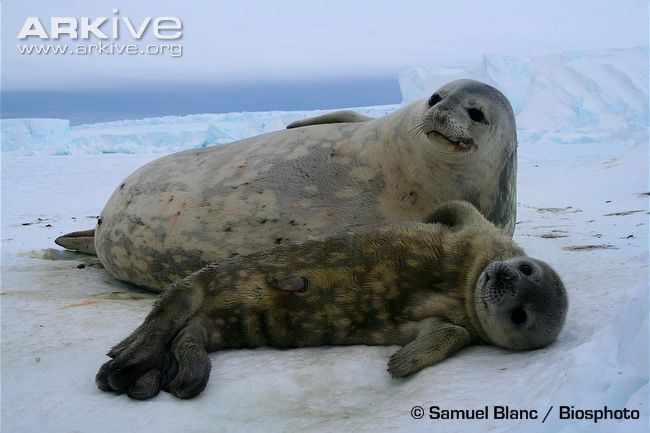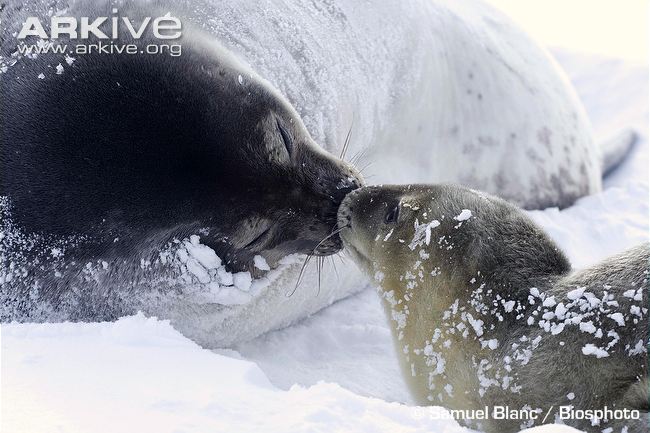Reproduction
Weddell seals
are marine mammals. This means that they give
birth to live offspring and produce milk for their
young. Their breeding season begins in October
(Doiron et al. 2012). During the first days of October,
pregnant females gather to form pupping colonies on
traditional breeding grounds that are
protected by males
swimming underneath the ice (Doiron et al. 2012). Pupping
colonies are created to give birth to their young in a
safe environment. Little Weddell
 pups are born a
day after pupping colonies are formed (Doiron
et al. 2012). Since Weddell seals are mammals, the pups are dependent
on their mother for nurture. This causes strong
bonds between mothers and their pups.
pups are born a
day after pupping colonies are formed (Doiron
et al. 2012). Since Weddell seals are mammals, the pups are dependent
on their mother for nurture. This causes strong
bonds between mothers and their pups.
Mother Weddell seals and their pup share special
callings to communicate with one another. Mother
and pup pairs use contact calls during nursing and other
daily interactions (Collins et al. 2011). Occasionally,
Weddell pups like to mischievously wander off and get
separated from their mother. When a mother and pup
are separated from one another, they both use
distinctive calls to reunite (Collins et al. 2011). When
Weddell pups are born, they feed off their mother’s milk
until they are weaned. On average this occurs 42
days after the pup is born (Proffi
et al. 2010). After
pups are weaned, they are taught how to hunt for their
own food. Shortly after Weddell pups learn how to
fend for themselves, they leave their mothers and to
find mates.
(Proffi
et al. 2010). After
pups are weaned, they are taught how to hunt for their
own food. Shortly after Weddell pups learn how to
fend for themselves, they leave their mothers and to
find mates.
After female Weddell seals have weaned their young, they return back to the sea to find another mate (Doiron et al. 2012). Female and males mate together underwater in traditional mating grounds. Male Weddell seals expose high fidelity to mating sites (Doiron et al. 2012). This means that males tend to return to the same area to find a female to mate with. Weddell seal mothers are biased towards producing and caring for male offspring (Proffitt et al. 2008). This biased behavior reflects the Triver-Willard model. This model predicts that mothers are able alter their bodies and behaviors to increase the survival rate of males to increase her fitness (Proffitt et al. 2008). Mother Weddell seals nurture male pups more than their female pups (Proffitt et al. 2008). This causes males to have a higher survival rate. A male pup has higher potential for producing more offspring in the future than female pup by the time they are weaned from their mother (Proffitt et al. 2008). This is why mothers who produce male offspring have a greater fitness and causes them to be biased towards them when mating.
List of references used in this section:
Collins K.T., P.D. McGreevy, K. E. Wheatley and R.G Harcourt. 2011. The influence of behavioral context on Weddell seal (Leptonychotes weddellii) airborne mother-pup vocalization. Behavioural Processes 87:286-290.
Doiron, E. E., P. A. Rouget, and J. M. Ternune. 2012. Proportional underwater call type usage by Weddell seals (Leptonychotes weddellii) in breeding and nonbreeding situations. Can. J. Zoology 90: 237-247
Proffitt, K. M., R. A. Garrott, and J. J. Rotella. 2008. Variation in offspring sex ratio among individual Weddell seal (Leptonychotes weddellii) females of different quality. Behavioral Ecology Sociobiology 62: 1679-1687
Proffitt, K. M., J. J. Rotella, and R. A. Garrott. 2010. Effects of pup age, maternal age, and birth date on pre-weaning survival rates of Weddell seals in Erebus Bay, Antarctica. Oikos 119: 1255-1264
Choose your adventure:
To learn how these seals interact with other organisms, click here.
OR
To return back to the home page, click here.